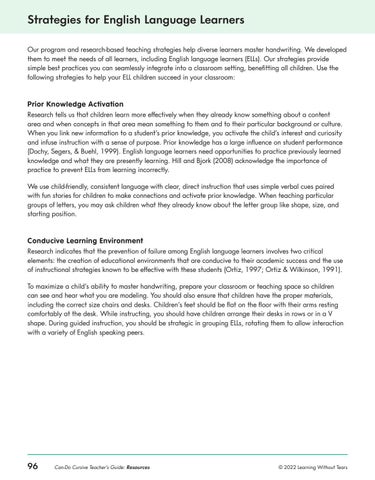Strategies for English Language Learners Our program and research-based teaching strategies help diverse learners master handwriting. We developed them to meet the needs of all learners, including English language learners (ELLs). Our strategies provide simple best practices you can seamlessly integrate into a classroom setting, benefitting all children. Use the following strategies to help your ELL children succeed in your classroom:
Prior Knowledge Activation Research tells us that children learn more effectively when they already know something about a content area and when concepts in that area mean something to them and to their particular background or culture. When you link new information to a student’s prior knowledge, you activate the child’s interest and curiosity and infuse instruction with a sense of purpose. Prior knowledge has a large influence on student performance (Dochy, Segers, & Buehl, 1999). English language learners need opportunities to practice previously learned knowledge and what they are presently learning. Hill and Bjork (2008) acknowledge the importance of practice to prevent ELLs from learning incorrectly. We use child-friendly, consistent language with clear, direct instruction that uses simple verbal cues paired with fun stories for children to make connections and activate prior knowledge. When teaching particular groups of letters, you may ask children what they already know about the letter group like shape, size, and starting position.
Conducive Learning Environment Research indicates that the prevention of failure among English language learners involves two critical elements: the creation of educational environments that are conducive to their academic success and the use of instructional strategies known to be effective with these students (Ortiz, 1997; Ortiz & Wilkinson, 1991). To maximize a child’s ability to master handwriting, prepare your classroom or teaching space so children can see and hear what you are modeling. You should also ensure that children have the proper materials, including the correct size chairs and desks. Children’s feet should be flat on the floor with their arms resting comfortably at the desk. While instructing, you should have children arrange their desks in rows or in a V shape. During guided instruction, you should be strategic in grouping ELLs, rotating them to allow interaction with a variety of English speaking peers.
96
Can-Do Cursive Teacher’s Guide: Resources
© 2022 Learning Without Tears













